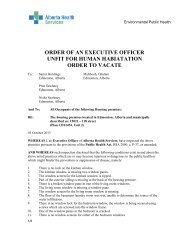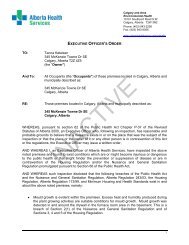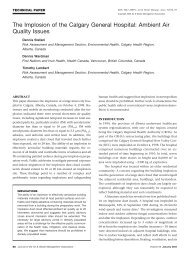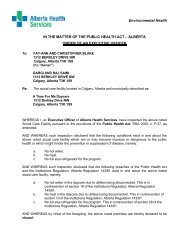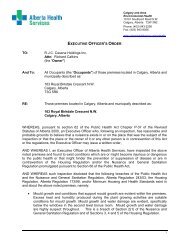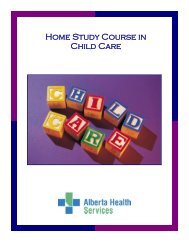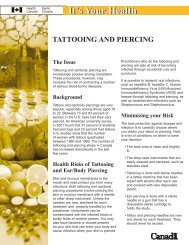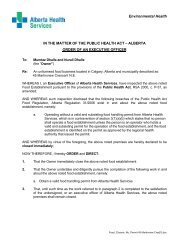guidelines for cleaning and maintenance of water coolers
guidelines for cleaning and maintenance of water coolers
guidelines for cleaning and maintenance of water coolers
Create successful ePaper yourself
Turn your PDF publications into a flip-book with our unique Google optimized e-Paper software.
Public Health<br />
Environmental Health<br />
10101 Southport Rd SW<br />
Calgary, Alberta T2W 3N2<br />
Phone: 403-943-2288<br />
Fax: 403-943-8056<br />
www.calgaryhealthregion.ca/envhealth<br />
GUIDELINES FOR CLEANING AND MAINTENANCE OF WATER COOLERS<br />
Frequency <strong>of</strong> Cleaning<br />
It is recommended that <strong>water</strong> <strong>coolers</strong> be thoroughly cleaned <strong>and</strong> disinfected with every bottle<br />
change.<br />
Cleaning the Water Cooler<br />
1. Disconnect the <strong>water</strong> cooler from the electrical outlet.<br />
2. Remove the empty <strong>water</strong> bottle <strong>and</strong> completely drain the remaining <strong>water</strong> through the<br />
spigots.<br />
3. Remove the “no-spill” guard <strong>and</strong> baffle (if applicable) – take care not to break or damage<br />
these components. These items can be cleaned in a dishwasher or manually in the<br />
kitchen sink.<br />
4. Prepare a disinfectant solution. In a large, clean, food-grade container dilute 15 mL (1<br />
Tablespoon) <strong>of</strong> non-perfumed bleach (~5% chlorine) into 5 L <strong>of</strong> clean warm <strong>water</strong>. Fill the<br />
reservoir with the disinfectant solution <strong>and</strong> scrub the interior <strong>of</strong> the reservoir with a clean<br />
long-h<strong>and</strong>led, s<strong>of</strong>t-bristled brush.<br />
5. Drain some <strong>of</strong> the disinfectant solution through the spigots, <strong>and</strong> allow the solution to sit <strong>for</strong><br />
at least 2 minutes (to be effective) but no longer than 5 minutes (to prevent corrosion).<br />
6. Drain the disinfectant solution from the reservoir through the spigots, into a bucket, <strong>and</strong><br />
dispose <strong>of</strong> the solution into the sanitary system.<br />
7. Rinse the reservoir thoroughly by filling it with clean tap <strong>water</strong> or bottled <strong>water</strong> 2-3 times.<br />
Drain the rinse <strong>water</strong> through the spigots into a bucket <strong>and</strong> dispose into the sanitary<br />
system. Rinsing the reservoir will remove traces <strong>of</strong> the disinfectant.<br />
8. Replace the baffle <strong>and</strong> the “no-spill” guard.<br />
9. Place <strong>water</strong> bottle on top <strong>of</strong> <strong>water</strong> cooler.<br />
10. Depress spigots until the <strong>water</strong> flows freely.<br />
11. Connect the <strong>water</strong> cooler to the electrical outlet.<br />
Note: this procedure is most easily per<strong>for</strong>med when replacing an empty <strong>water</strong> bottle.<br />
Cleaning Plastic Parts<br />
1. Periodic <strong>cleaning</strong> <strong>of</strong> the drip tray, spigot paddles, “no-spill” guard, baffles, <strong>and</strong> the exterior<br />
<strong>of</strong> the <strong>water</strong> cooler is recommended. This should be done when the <strong>water</strong> cooler is<br />
cleaned <strong>and</strong> disinfected. Removable parts can be cleaned in a dishwasher (see<br />
manufacturer’s instructions) or manually.<br />
2. All removable parts should be washed in hot soapy <strong>water</strong>, rinsed with clean <strong>water</strong> <strong>and</strong> then<br />
disinfected using a disinfectant solution (see Step 4).<br />
3. Allow the parts to thoroughly dry, or dry with a clean cloth.<br />
1
4. The exterior <strong>of</strong> the <strong>water</strong> cooler should be thoroughly wiped with a clean hot soapy cloth.<br />
5. Do not use abrasive cleansers, which can scratch surfaces.<br />
Maintenance<br />
1. At regular intervals, inspect the wire grid located across the back <strong>of</strong> the <strong>water</strong> cooler <strong>for</strong><br />
lint <strong>and</strong> dust build up. Vacuum or clean with a brush. Regular <strong>cleaning</strong> will help to keep<br />
the cooler running efficiently <strong>and</strong> economically.<br />
2. The compressor is hermetically sealed <strong>and</strong> requires no lubrication. Most units are also<br />
fitted with an automatic reset overload protection switch.<br />
3. Disconnect the <strong>water</strong> cooler from the electrical outlet whenever it is out <strong>of</strong> <strong>water</strong>.<br />
Note: always disconnect the <strong>water</strong> cooler from the power supply be<strong>for</strong>e any <strong>cleaning</strong> or<br />
per<strong>for</strong>ming other activities with the cooler.<br />
Inappropriate Bottled Water Uses<br />
Because bottled <strong>water</strong> normally contains low numbers <strong>of</strong> bacteria, it is recommended that<br />
you:<br />
Do not use bottled <strong>water</strong> to clean contact lenses.<br />
Do not use bottled <strong>water</strong> <strong>for</strong> infants less than 4 months old (unless boiled <strong>for</strong> 1 minute<br />
first).<br />
Do not use bottled <strong>water</strong> if you are a member <strong>of</strong> any immune deficient population (unless<br />
boiled <strong>for</strong> 1 minute first).<br />
Bottled Water Hygiene<br />
Wash h<strong>and</strong>s thoroughly with warm <strong>water</strong> <strong>and</strong> soap after using the washroom, after h<strong>and</strong>ling<br />
dirty items, <strong>and</strong> always BEFORE touching <strong>water</strong> containers. Water <strong>coolers</strong> can become<br />
contaminated with bacteria that originate from non-sanitary practices.<br />
Do not touch the end <strong>of</strong> the <strong>water</strong> cooler spigots with your h<strong>and</strong>s or any items that have<br />
come in contact with your mouth (glasses, cups, small <strong>water</strong> bottles, etc.).<br />
Replacing a Water Bottle on a Water Cooler<br />
1. Wash h<strong>and</strong>s thoroughly with warm <strong>water</strong> <strong>and</strong> soap be<strong>for</strong>e h<strong>and</strong>ling the “new” bottles.<br />
2. Remove the empty <strong>water</strong> bottle.<br />
3. Wipe the neck <strong>and</strong> shoulder <strong>of</strong> the “new” bottle with a clean hot soapy cloth, <strong>and</strong> also<br />
wipe the top <strong>of</strong> the <strong>water</strong> cooler <strong>and</strong> the lip <strong>of</strong> the reservoir.<br />
4. Remove the cap or seal from the “new” bottle <strong>and</strong> place it on the cooler, centering the<br />
bottle on the “no-spill” probe tip.<br />
For more in<strong>for</strong>mation, contact your Public Health Inspector at 403-943-8096.<br />
Source: Technical Advisory Committee on Safe Drinking Water, Environmental Public Health Field<br />
Manual <strong>for</strong> Private, Public <strong>and</strong> Communal Drinking Water Systems in Alberta, 2 nd Edition, 2004<br />
Calgary Health Region, Environmental Health, 2005<br />
2



